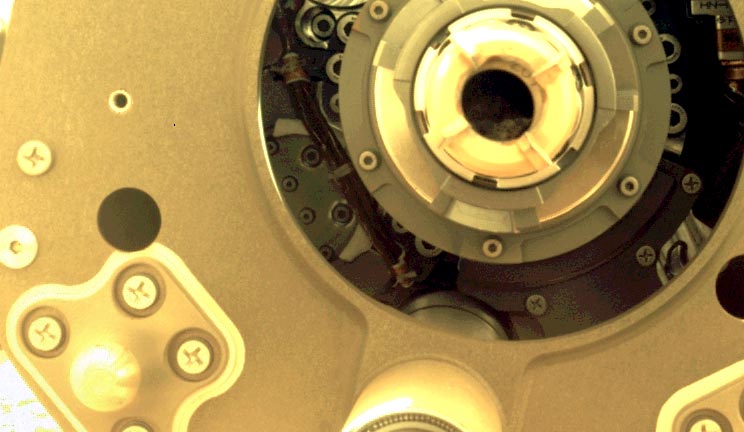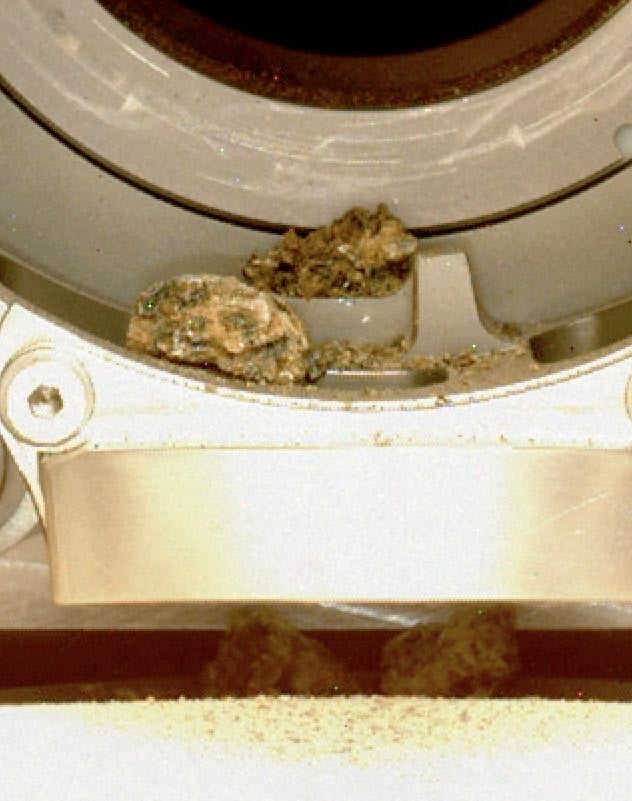Debris in Perseverance’s Bit Carousel: Pebble-sized debris can be seen in the bit carousel of NASA’s Perseverance Mars rover in this January 7, 2022, image. Credit: NASA/JPL-Caltech/MSSS
On Wednesday, December 29 (sol 306) Perseverance successfully cored and extracted a sample from a
Zoomed-in view of the WATSON (Wide Angle Topographic Sensor for Operations and eNgineering) image, highlighting the location of the sample debris. The area within the blue box is roughly 6.5 millimeters squared. Credit: NASA/JPL-Caltech/MSSS
The anomaly occurred during “Coring Bit Dropoff.” It’s when the drill bit, with its sample tube and just-cored sample nestled inside, is guided out of the percussive drill (at the end of the robotic arm) and into the bit carousel (which is located on the rover’s chassis). During processing of previous cored rock samples, the coring bit traveled 5.15 inches (13.1 centimeters) before sensors began to record the kind of resistance (drag) expected at first contact with the carousel structure. However, this time around the sensor recorded higher resistance than usual at about 0.4 inches (1 centimeter) earlier than expected, and some much higher resistance than expected during the operation.
The team requested additional data and imagery to ensure proper understanding of the state post anomaly. Because we are presently operating through a set of “restricted Sols” in which the latency of the data restricts the type of activities we can perform on Mars, it has taken about a week to receive the additional diagnostic data needed to understand this anomaly.

Imaging Perseverance’s Sample: This image shows the cored-rock sample remaining in the sample tube after the drill bit was extracted from Perseverance’s bit carousel on January 7, 2022. Credit: NASA/JPL-Caltech
Armed with that data set, we sent up a command to extract the drill bit and sample-filled tube from the bit carousel and undock the robotic arm from the bit carousel. During these activities, a series of hardware images were acquired.
The extraction took place on January 6, 2022, and data was downlinked early in the morning on January 7. These most recent downlinked images confirm that inside the bit carousel there are a few pieces of pebble-sized debris. The team is confident that these are fragments of the cored rock that fell out of the sample tube at the time of Coring Bit Dropoff, and that they prevented the bit from seating completely in the bit carousel.
The designers of the bit carousel did take into consideration the ability to continue to successfully operate with debris. However, this is the first time we are doing a debris removal and we want to take whatever time is necessary to ensure these pebbles exit in a controlled and orderly fashion. We are going to continue to evaluate our data sets over the weekend.
This is not the first curve Mars has thrown at us – just the latest. One thing we’ve found is that when the engineering challenge is hundreds of millions of miles away (Mars is currently 215 million miles from Earth), it pays to take your time and be thorough. We are going to do that here. So that when we do hit the unpaved Martian road again, Perseverance sample collection is also ready to roll.
Written by Louise Jandura, Chief Engineer for Sampling & Caching at (function(d, s, id){
var js, fjs = d.getElementsByTagName(s)[0];
if (d.getElementById(id)) return;
js = d.createElement(s); js.id = id;
js.src = "https://connect.facebook.net/en_US/sdk.js#xfbml=1&version=v2.6";
fjs.parentNode.insertBefore(js, fjs);
}(document, 'script', 'facebook-jssdk'));
Read original article here
